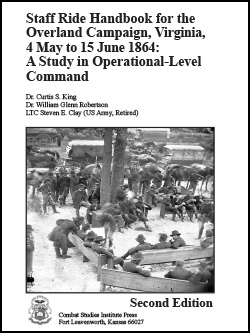
A Study in Operational-Level Command
By Dr. Curtis S. King; Dr. William Glenn Robertson; LTC Steven E. Clay (US Army, Retired)
510 Pages
Published: 2009
This Second Edition of the Staff Ride Handbook for the Overland Campaign, Virginia, 4 May to 15 June 1864, is an update to the tenth study in the Combat Studies Institute’s (CSI) Staff Ride Handbook series. The original handbook, prepared by Dr. Curtis S. King, Dr. William Glenn Robertson, and LTC Steven E. Clay (US Army, Retired), analyzed Lieutenant General Ulysses S. Grant’s 1864 Overland Campaign from the crossing of the Rapidan River on 4 May to the initiation of the crossing of the James River on 15 June. This new edition carries the story across the James and encompasses the initial assaults on Petersburg as well. Unlike many of CSI’s previous handbooks, this handbook focuses on the operational level of war. Even so, it provides a heavy dose of tactical analysis, thereby making this ride a superb tool for developing Army leaders at almost all levels.
Designed to be completed in three days, this staff ride is flexible enough to allow units to conduct a one-day or two-day ride that will still enable soldiers to gain a full range of insights offered by the study of this important campaign. In developing their plan for conducting an Overland Campaign staff ride, unit commanders are encouraged to consider analyzing the wide range of military problems associated with warfighting that this study offers. This campaign provides a host of issues to be examined, to include logistics, intelligence, psychological operations, use of reconnaissance (or lack thereof), deception, leadership, engineering, campaign planning, soldier initiative, and many other areas relevant to the modern military professional.
Download the PDF 